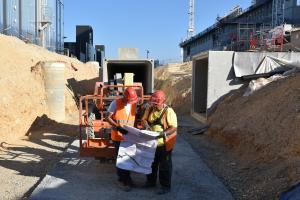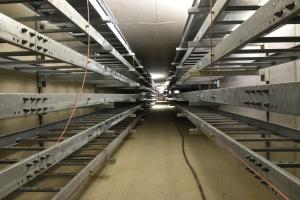Worksite
Inside the ITER catacombs
10 Sep 2018
-
Kirsten Haupt
If you were to drive on the three kilometres of worksite roads cutting across the ITER platform you would have to be very attentive. These roads change their course frequently. The reason for these changes often lies underground.
A service tunnel opens up at a junction where workers install pre-fabricated elements to connect the galleries coming from three directions. The opening offers a view of the Tokamak Complex on the right and the cryoplant on the left.
When fully established, three distinct infrastructure networks will be buried underneath the ITER road system like catacombs connecting all buildings and structures: the rain water network at a depth of ten metres; the service galleries for electricity and communications at a depth of five metres; and the water and gas networks at a depth of one to two metres.
The networks are being put into the ground one after the other. The first one, for rain water drainage, was completed several years ago. Deep underground pipes measuring up to 2.2 metres in diameter run for 1.6 kilometres under the platform to evacuate rain water to the storm basins located at the southwest corner of the ITER site.
Cable trays line the two sides of the electrical service tunnel like bunk beds. "You could walk these tunnels from the cooling towers on the east side of the worksite to just outside the grid yard on the west side," says Laurent Schmieder.
The middle-depth service galleries in the vicinity of the Tokamak Complex were put in place in 2014, in advance of building construction, with ends often closed up temporarily by wooden planks. Successively, as evidenced by gaping holes seen in different areas on the platform, this network with an overall length of about five kilometres is being extended to other buildings and structures on the worksite.
"A current priority is to finish the service gallery structure leading to the cryoplant and the twin buildings for magnet power conversion," says Laurent Schmieder, project manager for the European Domestic Agency that is in charge of all site work. "Power and water will soon be needed as plant equipment testing gets underway."
The water and gas supply network is the shallowest of the three, but with 30 kilometres of galleries also the most extensive. It carries breathing air for the respiratory equipment in underground structures, compressed air for instrument control, and other gases for operational purposes all across the worksite. Operational water supply, hot water, potable water as well as water for fire protection is also provided through this network. Finally, shallow drainage pipes collect rain water from the platform and then connect to the deep drainage system and the storm basins.
The completion of these hidden underground supply networks tracks to the overall project schedule. In order to identify upcoming priorities, Schmieder and his team closely coordinate with ENGAGE, the European Domestic Agency's architect-engineer contractor responsible for all civil works and service installation activities on site, and with MOMENTUM, ITER's Construction Manager-as-Agent.
As long as the supply networks continue to take shape in the ITER underworld, the roads aboveground on the ITER worksite will keep changing.



